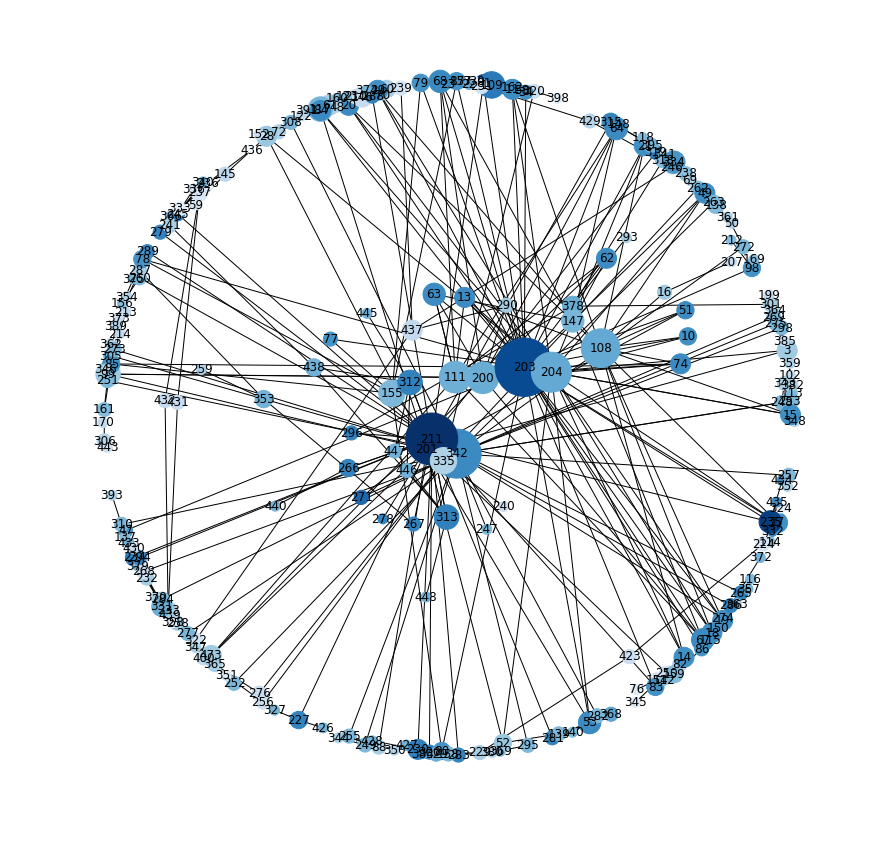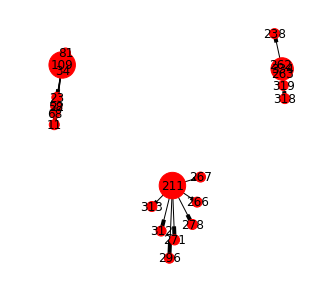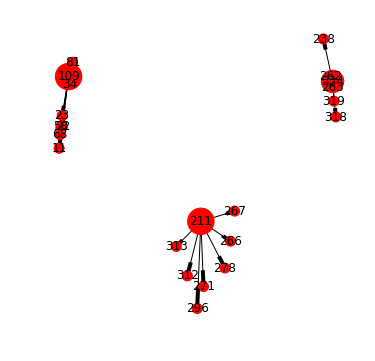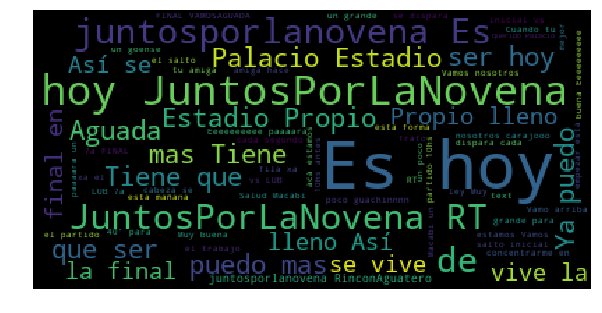Para cargar la base de datos de grafos hay que copiar todos los archivos de la carpeta graphdb a la carpeta /var/lib/neo4j/data/databases/graph.db/ .
sudo cp -v /graphdb/* /var/lib/neo4j/data/databases/graph.db/
Análisis de la red de tweets y usuarios relacionados con la final de la Liga Uruguaya de Basketball (LUB).
Trabajo final del curso "De las redes complejas a las redes sociales: Introducción al Uso del Big Data"
- Andrea Apolaro
- Guzmán López
- Leticia Vidal
- Ricardo Rezzano
En el marco del curso ...
Se utilizó el lenguaje de programación Python (versión 3.6.1) ...
# Import python libraries
import tweepy
import time
from random import choice
from py2neo import authenticate, Graph
import cypher
import networkx as nx
import matplotlib
import matplotlib.pyplot as plt
%matplotlib inlineAutenticación de Twitter y Neo4j mediante la lectura de un archivo externo con las claves requeridas:
# Twitter OAuthentication
consumer_key = "XXXXXXXXXX"
consumer_secret = "XXXXXXXXXX"
access_token = "XXXXXXXXXX"
access_token_secret = "XXXXXXXXXX"
auth = tweepy.OAuthHandler(consumer_key, consumer_secret)
auth.set_access_token(access_token, access_token_secret)
# Neo4j
neo4jUser = "xxxx"
neo4jPass = "xxxx"# Authentication credentials for Tweeter and Neo4j credentials
with open('/home/guzman/Documentos/Cursos/Redes Complejas - Introducción al uso del Big Data/Python/twitter-OAuth.py') as oauth:
exec(oauth.read())# Create API
api = tweepy.API(auth, wait_on_rate_limit=True, wait_on_rate_limit_notify=True, compression=True)%%sh
# Start neo4j service
systemctl start neo4j.service
# Check status of neo4j service
systemctl status neo4j.service● neo4j.service - Neo4j
Loaded: loaded (/usr/lib/systemd/system/neo4j.service; disabled; vendor preset: disabled)
Active: active (running) since Thu 2017-06-08 10:13:41 -03; 4ms ago
Process: 3895 ExecStart=/usr/bin/neo4j start (code=exited, status=0/SUCCESS)
Main PID: 3955 (java)
Tasks: 36 (limit: 4915)
Memory: 22.6M
CPU: 134ms
CGroup: /system.slice/neo4j.service
└─3955 /usr/sbin/java -cp /usr/share/java/neo4j/plugins:/etc/neo4j:/usr/share/java/neo4j/*:/usr/share/java/neo4j/plugins/* -server -XX:+UseG1GC -XX:-OmitStackTraceInFastThrow -XX:hashCode=5 -XX:+AlwaysPreTouch -XX:+UnlockExperimentalVMOptions -XX:+TrustFinalNonStaticFields -XX:+DisableExplicitGC -Djdk.tls.ephemeralDHKeySize=2048 -Dunsupported.dbms.udc.source=tarball -Dfile.encoding=UTF-8 org.neo4j.server.CommunityEntryPoint --home-dir=/usr/share/neo4j --config-dir=/etc/neo4j
jun 08 10:13:41 carqueja systemd[1]: Starting Neo4j...
jun 08 10:13:41 carqueja neo4j[3895]: Starting Neo4j.
jun 08 10:13:41 carqueja neo4j[3895]: Started neo4j (pid 3955). By default, it is available at http://localhost:7474/
jun 08 10:13:41 carqueja systemd[1]: Started Neo4j.
Autenticación de la base de datos no relacional Neo4j a través de la lectura del archivo externo con las claves de usuario y contraseña requeridas leído anteriormente.
# Neo4j DB graph authentication
# Connect to graph
url = "http://localhost:7474/db/data/"
authenticate("localhost:7474", neo4jUser, neo4jPass)
graph = Graph(url)
# Authentication for cypher package
connPar = "http://" + neo4jUser + ":" + neo4jPass + "@localhost:7474/db/data/"# Add uniqueness constraints
graph.run("CREATE CONSTRAINT ON (t:Tweet) ASSERT t.id IS UNIQUE;")
graph.run("CREATE CONSTRAINT ON (u:User) ASSERT u.screen_name IS UNIQUE;")
graph.run("CREATE CONSTRAINT ON (h:Hashtag) ASSERT h.name IS UNIQUE;")
graph.run("CREATE CONSTRAINT ON (l:Link) ASSERT l.url IS UNIQUE;")
graph.run("CREATE CONSTRAINT ON (s:Source) ASSERT s.name IS UNIQUE;")# Query words
queries = ["aguada", "aguatero", "hebraica", "macabi", "finalesLUB", "juntosporlanovena", "vamossha", "finaleslub"]Crear un archivo de texto vacío para adjuntar (escribir) los nombres de los usuarios de los tweets encontrados:
# Open file connection to append usernames
ufile = open("usernames_{}.txt".format("aguada-hebraica"), "a")# Pass dict to Cypher and build query from cypher script file
with open('/home/guzman/Documentos/GitLab/ComplexNetworks/Cypher/queries-in-script.cypher') as query:
query = query.read()
print(query)UNWIND {tweets} AS t
WITH t
ORDER BY t.id
WITH t,
t.entities AS e,
t.user AS u,
t.retweeted_status AS retweet
MERGE (tweet:Tweet {id:t.id})
SET tweet.text = t.text,
tweet.created_at = t.created_at,
tweet.favorites = t.favorite_count
MERGE (user:User {screen_name:u.screen_name})
SET user.name = u.name,
user.location = u.location,
user.followers = u.followers_count,
user.following = u.friends_count,
user.statuses = u.statuses_count,
user.profile_image_url = u.profile_image_url
MERGE (user)-[:POSTS]->(tweet)
MERGE (source:Source {name:t.source})
MERGE (tweet)-[:USING]->(source)
FOREACH (h IN e.hashtags |
MERGE (tag:Hashtag {name:LOWER(h.text)})
MERGE (tag)-[:TAGS]->(tweet)
)
FOREACH (u IN e.urls |
MERGE (url:Link {url:u.expanded_url})
MERGE (tweet)-[:CONTAINS]->(url)
)
FOREACH (m IN e.user_mentions |
MERGE (mentioned:User {screen_name:m.screen_name})
ON CREATE SET mentioned.name = m.name
MERGE (tweet)-[:MENTIONS]->(mentioned)
)
FOREACH (r IN [r IN [t.in_reply_to_status_id] WHERE r IS NOT NULL] |
MERGE (reply_tweet:Tweet {id:r})
MERGE (tweet)-[:REPLY_TO]->(reply_tweet)
)
FOREACH (retweet_id IN [x IN [retweet.id] WHERE x IS NOT NULL] |
MERGE (retweet_tweet:Tweet {id:retweet_id})
MERGE (tweet)-[:RETWEETS]->(retweet_tweet)
)
# Parameters
count = 100 # The number of tweets to return per page, up to a maximum of 100. Defaults to 15.
result_type = "mixed" # Include both popular and real time results in the response.
until = "2017-06-04" # Returns tweets created before the given date.
lang = "es" # Restricts tweets to the given language
since_id = -1 # Returns results with an ID greater than (that is, more recent than) the specified ID.Definir una función para la búsqueda de tweets que contiene la función de búsqueda de tweets de la librería tweepy y recibe como parámetros las palabras clave de búsqueda y el ID.
def search_tweets(query, since_id):
return api.search(q=query, count=count, until=until, result_type=result_type, lang=lang, since_id=since_id)Iterar buscando tweets a partir de las palabras claves en la búsqueda y ejecutando el código importado en Cypher para insertar los registros en la base de datos no relacional de Neo4j.
while True:
try:
q = choice(queries)
tweets = search_tweets(q, since_id)
if tweets:
plural = "s." if len(tweets) > 1 else "."
print("Found " + str(len(tweets)) + " tweet" + plural)
else:
print("No tweets found.\n")
time.sleep(65)
continue
since_id = tweets[0].id
# Send Cypher query.
graph.run(query, tweets=[tweet._json for tweet in tweets])
# adding users to user list
for tweet in tweets:
ufile.write(tweet.user.screen_name+"\n")
print("Tweets added to graph! \n")
time.sleep(33)
except Exception as e:
print(e)
time.sleep(33)
continue# Query Neo4j
#results = cypher.run('MATCH usPostw=(:User)-[r:POSTS]->(:Tweet) \
# MATCH twRettw=(:Tweet)-[r2:RETWEETS]->(:Tweet) \
# MATCH twReptw=(:Tweet)-[r3:REPLY_TO]->(:Tweet) \
# MATCH twMenus=(:Tweet)-[r4:MENTIONS]->(:User) \
# RETURN usPostw,twRettw,twReptw,twMenus \
# LIMIT 100000;', conn=connPar)
results = cypher.run('MATCH (n:User)-[r]-(m:Tweet) \
RETURN n,r,m;', conn=connPar)
# Create graph object from Neo4j
g = results.get_graph()
# View info
print(nx.info(g))442 rows affected.
Name:
Type: MultiDiGraph
Number of nodes: 402
Number of edges: 442
Average in degree: 1.0995
Average out degree: 1.0995
# Create network layout for visualizations
spring_pos = nx.spring_layout(g)
# Plot graph
matplotlib.rcParams['figure.figsize'] = (12, 12)
plt.axis("off")
nx.draw_networkx(g, pos = spring_pos, with_labels = False, node_size = 20)Gráfico del grafo donde el tamaño es directamente proporcional a la cantidad de conexiones de un nodo y así como también la escala de colores del azul al rojo:
d = nx.degree(g)
# Plot graph
matplotlib.rcParams['figure.figsize'] = (18, 18)
plt.axis("off")
nx.draw_networkx(g, pos = spring_pos, with_labels = True, nodelist=d.keys(), node_size=[v * 50 for v in d.values()])# View first five nodes
i = 0
for i in range(0,5):
print(str(i + 1) + "- " + str(g.nodes(data=True)[i]))
i = i + 11- ('1', {'favorites': 0, 'created_at': 'Wed May 31 21:14:07 +0000 2017', 'id': 870025622801838080, 'text': 'RT @KarinaAguatera: tamos ahí @sandynyordi #JuntosPorLaNovena https://t.co/x2kWrWLrS2', 'labels': ['Tweet']})
2- ('100', {'followers': 190, 'screen_name': 'KarinaAguatera', 'following': 964, 'name': '@JAKCARBONEROS', 'statuses': 1725, 'profile_image_url': 'http://pbs.twimg.com/profile_images/871221543908638720/x4FSyHJs_normal.jpg', 'location': 'montevideo', 'labels': ['User']})
3- ('2', {'favorites': 1, 'created_at': 'Wed May 31 21:24:58 +0000 2017', 'id': 870028352631054336, 'text': 'mi trabajo de parto duro menos q sacar las entradas para la última final. #JuntosPorLaNovena', 'labels': ['Tweet']})
4- ('0', {'favorites': 2, 'created_at': 'Wed May 31 21:03:11 +0000 2017', 'id': 870022870512152577, 'text': 'tamos ahí @sandynyordi #JuntosPorLaNovena https://t.co/x2kWrWLrS2', 'labels': ['Tweet']})
5- ('101', {'followers': 24, 'screen_name': 'sandynyordi', 'following': 183, 'name': '° SANDY ☆', 'statuses': 193, 'profile_image_url': 'http://pbs.twimg.com/profile_images/869902165720039425/hxWQH2WE_normal.jpg', 'location': '', 'labels': ['User']})
# View first five edges
i = 0
for i in range(0,5):
print(str(i + 1) + "- " + str(g.edges(data=True)[i]))
i = i + 11- ('1', '100', {'type': 'MENTIONS'})
2- ('1', '101', {'type': 'MENTIONS'})
3- ('100', '2', {'type': 'POSTS'})
4- ('100', '0', {'type': 'POSTS'})
5- ('0', '101', {'type': 'MENTIONS'})
# Tipos de nodos (Usuarios y Tweets)
# Count User nodes
#resultsUserNodes = cypher.run('ALGO', conn=connPar)
# Consulta networkx
#fish2 = (n for n,d in G.nodes_iter(data=True) if d['label']=='fish')
#resultsUserNodes.dataframe# Tipo de grafo
esMultigrafo = g.is_multigraph()
esDireccional = g.is_directed()
esConectado = nx.is_connected(g.to_undirected())
# Número de nodos y conexiones
numNod = nx.number_of_nodes(g)
numEdg = nx.number_of_edges(g)
# Grados de un nodo (máximo, mínimo, promedio)
deg = nx.degree(g)
in_degrees = g.in_degree()
out_degrees = g.out_degree()
# Componentes conectados
if not esConectado:
g2 = g.to_undirected() # saco direccionalidad
# Número de componentes conectados
numConComp = nx.number_connected_components(g2)
# Resumen
print("| -------------------------------------------- |")
if esMultigrafo:
print("| Tipo de grafo: Multigrafo")
if not esMultigrafo:
print("| Tipo de grafo: Simple")
if esDireccional:
print("| Direccional: Si")
if not esDireccional:
print("| Direccional: No")
if esConectado:
print("| Conectado: Si")
if not esConectado:
print("| Conectado: No")
print("| -------------------------------------------- |")
print("| Número de nodos:", str(numNod))
print("| Número de conexiones:", str(numEdg))
print("| -------------------------------------------- |")
print("| Grado máximo entrada:", str(max(in_degrees.values())))
print("| Grado mínimo entrada:", str(min(in_degrees.values())))
print("| Grado promedio entrada:", str(sum(in_degrees.values())/len(deg.values())))
print("| -------------------------------------------- |")
print("| Grado máximo salida:", str(max(out_degrees.values())))
print("| Grado mínimo salida:", str(min(out_degrees.values())))
print("| Grado promedio salida:", str(sum(out_degrees.values())/len(deg.values())))
print("| -------------------------------------------- |")
print("| Grado máximo (no dir):", str(max(deg.values())))
print("| Grado mínimo (no dir):", str(min(deg.values())))
print("| Grado promedio (no dir):", str(sum(deg.values())/len(deg.values())))
print("| -------------------------------------------- |")
print("| Número total de componentes conectados: %d" % nx.number_connected_components(g2))
print("| -------------------------------------------- |")| -------------------------------------------- |
| Tipo de grafo: Multigrafo
| Direccional: Si
| Conectado: No
| -------------------------------------------- |
| Número de nodos: 402
| Número de conexiones: 442
| -------------------------------------------- |
| Grado máximo entrada: 34
| Grado mínimo entrada: 0
| Grado promedio entrada: 1.099502487562189
| -------------------------------------------- |
| Grado máximo salida: 7
| Grado mínimo salida: 0
| Grado promedio salida: 1.099502487562189
| -------------------------------------------- |
| Grado máximo (no dir): 34
| Grado mínimo (no dir): 1
| Grado promedio (no dir): 2.199004975124378
| -------------------------------------------- |
| Número total de componentes conectados: 45
| -------------------------------------------- |
# Subgrafos de componentes conectados
g2_conComp = list(nx.connected_component_subgraphs(g2))
# Definir función con las métricas adentro
def metricas_subgrafos(subgrafo):
# crear diccionario vacío
dict = {}
# métricas
numNodos = nx.number_of_nodes(subgrafo) # número de nodos
numConex = nx.number_of_edges(subgrafo) # número de conexiones
grados = nx.degree(subgrafo) # grados
maxGrado = max(grados.values()) # grado max
minGrado = min(grados.values()) # grado min
promGrado = sum(grados.values())/len(grados.values())
diametro = nx.diameter(subgrafo) # diámetro
radio = nx.radius(subgrafo) # radio
excentricidad = nx.eccentricity(subgrafo) # excentricidad
centro = nx.center(subgrafo) # centro
periferia = nx.periphery(subgrafo) # periferia
densidad = nx.density(subgrafo) # densidad
between = nx.betweenness_centrality_source(subgrafo) # betweenness
closeness = nx.closeness_centrality(subgrafo) # closeness
# agregar métricas al diccionario
dict['nodos'] = numNodos
dict['conexiones'] = numConex
dict['grados'] = grados
dict['maxgrado'] = maxGrado
dict['mingrado'] = minGrado
dict['promGrado'] = promGrado
dict['diámetro'] = diametro
dict['radio'] = radio
dict['excentricidad'] = excentricidad
dict['centro'] = centro
dict['periferia'] = periferia
dict['densidad'] = densidad
dict['betweenness'] = between
dict['closeness'] = closeness
# retorno
return dict
# Aplicar función metricas_subgrafos a todos los subgrafos
listaMetSubg = []
for subg in g2_conComp:
subgMet = metricas_subgrafos(subg)
listaMetSubg.append(subgMet)
# Ver métricas y plot del subgrafo principal: donde estań los nodos más importantes
import pandas as pd
for x in range(0,len(listaMetSubg)):
for v in listaMetSubg[x].values():
if(isinstance(v, list)):
for w in v:
if(w == '211'):
myDict = listaMetSubg[x]
i = x
# Hacer dataframe
df = pd.DataFrame()
df['Parámetro'] = myDict.keys()
df['Valores'] = myDict.values()
print('++++++++++++++++++++++++++++++++++++++++++++++++++++++++++++++++++++')
print(df)
print('++++++++++++++++++++++++++++++++++++++++++++++++++++++++++++++++++++')++++++++++++++++++++++++++++++++++++++++++++++++++++++++++++++++++++
Parámetro Valores
0 nodos 244
1 conexiones 325
2 grados {'308': 2, '232': 2, '247': 1, '113': 1, '345'...
3 maxgrado 34
4 mingrado 1
5 promGrado 2.66393
6 diámetro 16
7 radio 8
8 excentricidad {'308': 11, '232': 11, '247': 11, '113': 12, '...
9 centro [211]
10 periferia [436, 341]
11 densidad 0.0109627
12 betweenness {'308': 0.008230452674897118, '232': 0.0082304...
13 closeness {'308': 0.17737226277372262, '232': 0.15820312...
++++++++++++++++++++++++++++++++++++++++++++++++++++++++++++++++++++
El tamaño de los nodos es proporcional al grado del mismo y el color azul representa mayor betweenness
# Grados subgrafo
d = nx.degree(g2_conComp[i])
b = nx.betweenness_centrality(g2_conComp[i])
# Plot subgrafo
matplotlib.rcParams['figure.figsize'] = (15,15)
plt.axis("off")
nx.draw_networkx(g2_conComp[i], pos = spring_pos, with_labels = True,
nodelist=d.keys(), node_size=[v * 100 for v in d.values()],
cmap=plt.get_cmap('Blues'), node_color=[v for v in b.values()])El tamaño de los nodos es proporcional al grado del mismo y el color azul representa mayor closeness
# Grados subgrafo
c = nx.closeness_centrality(g2_conComp[i])
# Plot subgrafo
matplotlib.rcParams['figure.figsize'] = (15,15)
plt.axis("off")
nx.draw_networkx(g2_conComp[i], pos = spring_pos, with_labels = True,
nodelist=d.keys(), node_size=[v * 100 for v in d.values()],
cmap=plt.get_cmap('Blues'), node_color=[v for v in c.values()])# Select most output connected nodes
resultsDegOut = cypher.run('MATCH (n:User)-[r]->(m:Tweet) \
RETURN id(n) AS ID, n.screen_name AS NOMBRE, count(*) AS GRADO \
ORDER BY GRADO DESC LIMIT 10', conn=connPar)
resultsDegOut.dataframe10 rows affected.
<style>
.dataframe thead tr:only-child th {
text-align: right;
}
</style>
.dataframe thead th {
text-align: left;
}
.dataframe tbody tr th {
vertical-align: top;
}
| ID | NOMBRE | GRADO | |
|---|---|---|---|
| 0 | 109 | CesarGroba2016 | 7 |
| 1 | 211 | Hebraicaymacabi | 7 |
| 2 | 334 | AKolender | 5 |
| 3 | 117 | alcaide943 | 4 |
| 4 | 131 | carlosRocha1891 | 4 |
| 5 | 331 | MSTM1215 | 4 |
| 6 | 108 | daianab81 | 4 |
| 7 | 132 | Macucha23 | 3 |
| 8 | 107 | EduuCabrera19 | 3 |
| 9 | 159 | DanielaBrandon | 3 |
# Select most intput connected nodes
resultsDegIn = cypher.run('MATCH (n:User)<-[r]-(m:Tweet) \
RETURN id(n) AS ID, n.screen_name AS NOMBRE, count(*) AS GRADO \
ORDER BY GRADO DESC LIMIT 10', conn=connPar)
resultsDegIn.dataframe10 rows affected.
<style>
.dataframe thead tr:only-child th {
text-align: right;
}
</style>
.dataframe thead th {
text-align: left;
}
.dataframe tbody tr th {
vertical-align: top;
}
| ID | NOMBRE | GRADO | |
|---|---|---|---|
| 0 | 203 | Aguada_oficial | 34 |
| 1 | 342 | LUB_Uy | 23 |
| 2 | 211 | Hebraicaymacabi | 20 |
| 3 | 204 | RinconAguatero | 16 |
| 4 | 108 | daianab81 | 11 |
| 5 | 200 | PasionAguatera | 9 |
| 6 | 201 | HAguatera | 9 |
| 7 | 111 | Somos_Aguada | 8 |
| 8 | 424 | elmarcadortv | 6 |
| 9 | 335 | alenb259 | 6 |
matplotlib.rcParams['figure.figsize'] = (12, 12)
resultsInDeg = cypher.run('MATCH a=(n:User)<-[r]-(m:Tweet) \
WHERE n.screen_name = "Aguada_oficial" \
OR n.screen_name = "LUB_Uy"\
OR n.screen_name = "Hebraicaymacabi" \
OR n.screen_name = "RinconAguatero" \
RETURN a;', conn=connPar)
# Create graph object from Neo4j
gInDeg = resultsInDeg.get_graph()
# View info
print(nx.info(gInDeg))
dInDeg = nx.degree(gInDeg)
# Plot graph
plt.axis("off")
nx.draw_networkx(gInDeg, pos = spring_pos, with_labels = True, nodelist=dInDeg.keys(), node_size=[v * 50 for v in dInDeg.values()])93 rows affected.
Name:
Type: MultiDiGraph
Number of nodes: 81
Number of edges: 93
Average in degree: 1.1481
Average out degree: 1.1481
resultsOutDeg = cypher.run('MATCH a=(n:User)-[r]->(m:Tweet) \
WHERE n.screen_name = "CesarGroba2016" \
OR n.screen_name = "Hebraicaymacabi"\
OR n.screen_name = "AKolender" \
RETURN a;', conn=connPar)
# Create graph object from Neo4j
gOutDeg = resultsOutDeg.get_graph()
# View info
print(nx.info(gOutDeg))
dOutDeg = nx.degree(gOutDeg)
# Plot graph
matplotlib.rcParams['figure.figsize'] = (5, 5)
plt.axis("off")
nx.draw_networkx(gOutDeg, pos = spring_pos, with_labels = True, nodelist=dOutDeg.keys(), node_size=[v * 100 for v in dOutDeg.values()])19 rows affected.
Name:
Type: MultiDiGraph
Number of nodes: 22
Number of edges: 19
Average in degree: 0.8636
Average out degree: 0.8636
resultsDeg = cypher.run('MATCH (n:User)-[r]-(m:Tweet) \
RETURN id(n) AS ID, n.screen_name AS NOMBRE, count(*) AS GRADO \
ORDER BY GRADO DESC LIMIT 10', conn=connPar)
resultsDeg.dataframe10 rows affected.
<style>
.dataframe thead tr:only-child th {
text-align: right;
}
</style>
.dataframe thead th {
text-align: left;
}
.dataframe tbody tr th {
vertical-align: top;
}
| ID | NOMBRE | GRADO | |
|---|---|---|---|
| 0 | 203 | Aguada_oficial | 34 |
| 1 | 211 | Hebraicaymacabi | 27 |
| 2 | 342 | LUB_Uy | 24 |
| 3 | 204 | RinconAguatero | 16 |
| 4 | 108 | daianab81 | 15 |
| 5 | 200 | PasionAguatera | 10 |
| 6 | 111 | Somos_Aguada | 10 |
| 7 | 201 | HAguatera | 9 |
| 8 | 155 | Castro_AnaLaura | 7 |
| 9 | 335 | alenb259 | 7 |
resultsInOutDeg = cypher.run('MATCH a=(n:User)-[r]-(m:Tweet) \
WHERE n.screen_name = "CesarGroba2016" \
OR n.screen_name = "Hebraicaymacabi"\
OR n.screen_name = "AKolender" \
RETURN a;', conn=connPar)
# Create graph object from Neo4j
gInOutDeg = resultsOutDeg.get_graph()
# View info
print(nx.info(gInOutDeg))
dInOutDeg = nx.degree(gInOutDeg)
# Plot graph
matplotlib.rcParams['figure.figsize'] = (6, 6)
plt.axis("off")
nx.draw_networkx(gInOutDeg, pos = spring_pos, with_labels = True, nodelist=dInOutDeg.keys(), node_size=[v * 100 for v in dInOutDeg.values()])39 rows affected.
Name:
Type: MultiDiGraph
Number of nodes: 22
Number of edges: 19
Average in degree: 0.8636
Average out degree: 0.8636
Seleccionar todas las palabras de los tweets de los dos nodos más conectados para construir una nube de palabras:
# Nodo más conectado
resultsText1 = cypher.run('MATCH a=(n:User)-[r]-(m:Tweet) \
WHERE n.screen_name = "Aguada_oficial" \
RETURN DISTINCT(m.text);', conn=connPar)
# Open file connection to append resultsText
textAguadaOficial = open("AguadaOficialTweetText.txt", "a")
textAguadaOficial.write(str(resultsText1)+"/n")
# Segundo nodo más conectado
resultsText2 = cypher.run('MATCH a=(n:User)-[r]-(m:Tweet) \
WHERE n.screen_name = "Hebraicaymacabi" \
RETURN DISTINCT(m.text);', conn=connPar)
# Open file connection to append resultsText
textHebraicaymacabi = open("HebraicaymacabiTweetText.txt", "a")
textHebraicaymacabi.write(str(resultsText2)+"/n")16 rows affected.
16 rows affected.
3191
Ver nodo más conectado:
resultsText1.dataframe
<style>
.dataframe thead tr:only-child th {
text-align: right;
}
</style>
.dataframe thead th {
text-align: left;
}
.dataframe tbody tr th {
vertical-align: top;
}
| (m.text) | |
|---|---|
| 0 | RT @Mariog64: @Aguada_oficial @URUGUAYLATECAP ... |
| 1 | @cherrera88 @Aguada_oficial Eeeeeeeeee paaaara... |
| 2 | Es hoy #Juntosporlanovena 🙌🏼🙌🏼🙌🏼 @Aguada_ofici... |
| 3 | Y acá estamos! Vamos nosotros carajooo!!! #jun... |
| 4 | RT @Castro_AnaLaura: Es hoy #Juntosporlanovena... |
| 5 | 40' para el salto inicial @Aguada_oficial vs @... |
| 6 | Es hoy @Aguada_oficial !!! Vamo arriba !! 💪🏽 \... |
| 7 | Es hoy @Aguada_oficial ! #JuntosPorLaNovena #a... |
| 8 | Es hoy!!! Trato de concentrarme en el trabajo ... |
| 9 | Ya no puedo mas... Tiene que ser hoy!!! #Junto... |
| 10 | RT @Colet12: Cuando tu amiga hace la fila xa e... |
| 11 | RT @Titotimothytim: Ya no puedo mas... Tiene q... |
| 12 | RT @daianab81: A Palacio y Estadio Propio llen... |
| 13 | ES HOY @Aguada_oficial 💚❤️\n#juntosporlanovena |
| 14 | Que mejor que empezar esta mañana de esta form... |
| 15 | A Palacio y Estadio Propio lleno!!! Así se viv... |
Ver segundo nodo más conectado:
resultsText2.dataframe
<style>
.dataframe thead tr:only-child th {
text-align: right;
}
</style>
.dataframe thead th {
text-align: left;
}
.dataframe tbody tr th {
vertical-align: top;
}
| (m.text) | |
|---|---|
| 0 | RT @Hebraicaymacabi: La gloria: ¡MacaBI! ¡HACI... |
| 1 | RT @hundilacom: Crónica de la victoria de @Heb... |
| 2 | RT @Hebraicaymacabi: Sacamos 26! Abrazate! Hac... |
| 3 | RT @susanarosano1: @Hebraicaymacabi Felicitaci... |
| 4 | RT @Hebraicaymacabi: Final! Ganó Macabi 82 a 5... |
| 5 | RT @MarioNBarbato: @OPetinatti @Hebraicaymacab... |
| 6 | RT @abifitcoach: @OPetinatti @Hebraicaymacabi ... |
| 7 | RT @Mariog64: @Aguada_oficial @URUGUAYLATECAP ... |
| 8 | RT @dobleyfalta_uy: #LUB | las mejores imágene... |
| 9 | @Hebraicaymacabi MacaBI CAMPEÓN! Que huevo Heb... |
| 10 | RT @mago1377: @Hebraicaymacabi si señor un equ... |
| 11 | RT @Basketbol1010: los campeones Hebraica Maca... |
| 12 | La gloria: ¡MacaBI! ¡HACIENDO HISTORIA! https:... |
| 13 | RT @ElAguanteUy: Hebraica Macabi ganó la LUB y... |
| 14 | RT @LUB_Uy: Video Clip de la 7ma FINAL de LUB ... |
| 15 | 40' para el salto inicial @Aguada_oficial vs @... |
def cleanstr(filtro, fileStringName):
import re
# En primer lugar debemos de abrir el fichero que vamos a leer.
# Usa 'rb' en vez de 'r' si se trata de un fichero binario.
infile = open(fileStringName + '.txt', 'r')
outfile = open(fileStringName + 'Clean.txt', 'w') # Indicamos el valor 'w'.
outfile2 = open(fileStringName + 'Basura.txt', 'w') # Indicamos el valor 'w'.
# Mostramos por pantalla y escribe en un fichero lo que leemos desde el fichero y filtramos
print('>>> Lectura del fichero línea a línea')
for line in infile:
palabras = line.split()
for n in palabras:
if re.match('@.+', n):
outfile2.write(n + "\n")
elif re.match(" " + filtro + " ", n):
print(n)
#outfile2.writelines(n + "\n")
elif re.match('https', n):
outfile2.write(n + "\n")
else:
outfile.writelines(n + "\n")
# if re.match('(@.+)',line):
# cleanline= line
# print(line)
# outfile.write(cleanline)
# if re.search('^@', line):
# cleanline2=line
# print(cleanline2)
# outfile2.write(cleanline)
# Cerramos el fichero.
outfile.close()
outfile2.close()
infile.close()
print('>>> Termina proceso con exito')
# Prueba:
cleanstr('https😂', 'AguadaOficialTweetText')
cleanstr('https', 'HebraicaymacabiTweetText')>>> Lectura del fichero línea a línea
>>> Termina proceso con exito
>>> Lectura del fichero línea a línea
>>> Termina proceso con exito
from wordcloud import WordCloud, STOPWORDS
matplotlib.rcParams['figure.figsize'] = (10, 10)
#Convert all the required text into a single string here and store them in word_string
# you can specify fonts, stopwords, background color and other options
word_string1 = ""
infile = open('AguadaOficialTweetTextClean.txt', 'r')
for l in infile:
word_string1 = word_string1 + l
word_string2 = ""
infile = open('HebraicaymacabiTweetTextClean.txt', 'r')
for l in infile:
word_string2 = word_string2 + l
wordcloud1 = WordCloud(background_color='black')
wordcloud1.generate(word_string1)
wordcloud2 = WordCloud(background_color='black')
wordcloud2.generate(word_string2)
plt.imshow(wordcloud1)
plt.axis('off')
plt.show()
plt.imshow(wordcloud2)
plt.axis('off')
plt.show()








